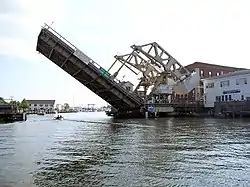Mystic Bridge Historic District
The Mystic Bridge Historic District is a historic district in the village of Mystic, Connecticut on the Stonington side of the Mystic River. It includes the Mystic Seaport Museum, whose grounds and floating vessels represent the area's history, and the 1924 Mystic River Bascule Bridge. The district is significant as a well-preserved shipbuilding and maritime village of the 19th and early 20th centuries,[2] and it was added to the National Register of Historic Places in 1979.[1]
Mystic Bridge Historic District | |
 | |
  | |
| Location | U.S. 1 and CT 27, Mystic, Connecticut |
|---|---|
| Coordinates | 41°21′25″N 71°57′51″W |
| Area | 155 acres (63 ha) |
| Built | 1840 |
| Architect | Clift, Amos, III; Multiple |
| Architectural style | Greek Revival, Italianate, Queen Anne |
| NRHP reference No. | 79002671[1] |
| Added to NRHP | August 31, 1979 |
History
Mystic developed in the early 19th century as a small seaport and shipbuilding center, businesses that were mostly located on the eastern shore of the Mystic River. The village is divided between the towns of Stonington and Groton, Connecticut. The Greenman family operated one of the village's largest shipyards, which now serves as the grounds of the Mystic Seaport Museum and still has some of the buildings used for that original purpose. The village declined in the late 19th century, as wooden ships gave way to those built of iron and steel.[2]
See also
References
- "National Register Information System". National Register of Historic Places. National Park Service. March 13, 2009.
- David F. Ransom (January 5, 1979). "National Register of Historic Places Inventory – Nomination Form: Mystic Bridge Historic District". National Park Service. Retrieved 2016-02-26.
External links
 Media related to Mystic Bridge Historic District at Wikimedia Commons
Media related to Mystic Bridge Historic District at Wikimedia Commons- Historic American Engineering Record (HAER) No. CT-174, "Mystic River Bridge, Spanning Mystic River at U.S. Route 1, Groton, New London County, CT"